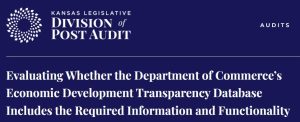A new report from the Kansas Legislative Division of Post Audit shows the Kansas Department of Commerce’s “transparency database” is out of compliance with state law.
In 2019, the Kansas Legislature passed legislation to create an economic development incentive program database, commonly known as the “transparency database.” The database must contain information about numerous economic incentive programs and recipients in Kansas and provide the public with information about them.
 Commerce is responsible for developing and maintaining the database, which includes information on programs—like certain tax credits—administered by other state agencies, such as the Kansas Department of Revenue.
Commerce is responsible for developing and maintaining the database, which includes information on programs—like certain tax credits—administered by other state agencies, such as the Kansas Department of Revenue.
What Post Audit found was that, in many cases, the database is out of compliance with state law.
Indeed, auditors said 13 of 60 programs they expected to find were missing from the database.
“In total, 13 of the 60 incentive programs (22%) we evaluated were absent from the database because they were missing from the program list, the recipient table, or both,” the report reads. “These included programs such as the Fire Marshal Tax Credit and the Economic Development Initiatives Fund.”
Post Audit specifically looked for the controversial STAR bond program, which the agency has audited before, and found it was not included in the database despite the law requiring it to be included by name.
“In the case of the STAR bonds program, statute specifically requires that information about STAR bonds be included in the database,” the auditors said in the report. “When we conducted our review, the STAR bonds program did not have any records in the recipient table. However, after our work was complete, we noticed the database homepage included separate buttons that took users to a STAR bonds overview page and a static PDF. That PDF contained a list of projects with certain information, such as principal officers. However, STAR bonds still lacked other statutorily required information, such as program history. Because it was not contained in the database, we did not evaluate it further.”
In its response Commerce complained that they provided more information than required.
“The report finds that STAR Bonds and EDIF are not in compliance,” Commerce wrote. “When in fact, the database provides MORE (sic.) information for those programs than what is statutorily required.”
However, as auditors noted, the information is on a separate website from the database and contained in a non-searchable, static PDF—and, therefore, not actually in the database.
“The department provided some required information outside of the database for programs such as STAR Bonds on their webpage,” auditors wrote. “However, we only evaluated whether the database itself (or a link within it) contained the information because that is what is required by statute. The inclusion of information in various forms and places on the department’s website does not appear to fulfill the statutory requirements.”
The transparency database also lacked about half of the 11 statutorily required program-level pieces of information for the 5 incentive programs — Child Day Care Assistance Tax Credit, Historic Preservation Tax Credit, Job Creation Fund, Private Activity Bonds, and Strategic Economic Expansion and Development (SEED) — Post Audit reviewed.
“Five of the statutorily required elements were absent from all 5 programs: compliance rate, return on investment, evaluations, total incentives by program, and total incentives by county,” auditors wrote. “One additional requirement, annual reports, was missing for 4 programs. In cases where we determined that information was absent, the database lacked explanations as to why that information was not included.
“For some requirements, the user had to take several steps to find or calculate the information for the 5 programs we reviewed. Incentive totals by program and by county could be obtained only by downloading the table of recipients into Excel. The user would then have to use formulas or other means to sum the awarded amounts by program and county. In other cases, information was only available by clicking through several links and searching for it manually or by downloading and searching a PDF document. Because the law requires that the information either be included directly in the database or available via a link, we considered this to be noncompliant.”
Post Audit recommended the legislature consider amending K.S.A. 74-50,227(b) to clarify what elements of required economic incentive program information should be included in the transparency database itself, and what elements would be acceptable to be available outside of the database, via links to other sources of information.
Auditors also recommended Commerce ensure the transparency database contains all statutorily required programs and information. If any information cannot be measured or included, the department should include an explanation on the database for why that information does not appear.


